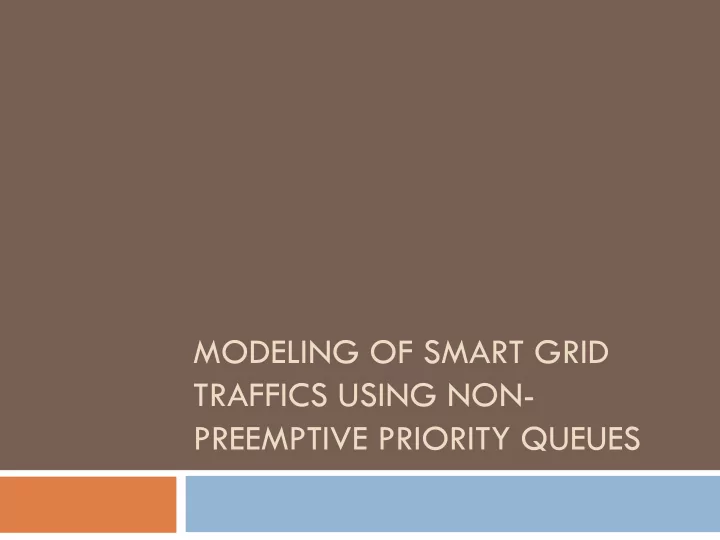

MODELING OF SMART GRID TRAFFICS USING NON- PREEMPTIVE PRIORITY QUEUES
Contents Smart Grid Model and Components. Future Smart grid components. Classification of Smart Grid Traffic. Brief explanation of Preemptive, Non-Preemptive and Weighted Round Robin methods. Proposed model and Simulation Results. Advantages and Disadvantages of the proposed model.
Need for this paper Smart grid has various applications making it very complex to manage network traffics Efficient control of network traffic to maximize the throughput of the system Simulating the smart grid traffics using non preemptive queues
Smart Grid Model
Smart Grid Components Customer : At customer domain, the electricity is consumed. This domain is usually partitioned into sub-domains for home, commercial building, and industrial. Market : This domain includes the operators and participants in electricity markets. In this domain the grid assets are bought and sold. Service providers : Service providers are organizations which provide services to electrical customers and utilities. Operations : In this domain the movement of electricity is managed. Example – Monitoring and Control. Bulk generation : In this domain by using other forms of energy the electricity is generated. There are two different sources for energy generation: renewable energy and nonrenewable energy. Transmission : Transmission is the process of carrying the bulk electricity over long distances. Using electrical transmission lines and multiple substations, the generated electrical power is transmitted from generation sources to distribution through multiple substations. Distribution : This domain is responsible to distribute the electricity to and from customers. The customer domain and their smart meters, distributed storage and distributed generation are connected to the transmission domain using distribution domain.
Smarter Grid
Why is traffic classification required? Utilities need to Each application in manage the traffic The traffics are the smart grid has requirements into tabled on the basis of traffic with different similar classes so that delay, bandwidth and requirements they can process the packet loss multiple applications
Classification of Smart Grid Traffics Traffic Class Latency(ms) Bandwidth(kb/s) Applications Class 1 8-10 64 Teleprotection Class 2 100 1.2-64 WACS Class 3 16 2048 PMU Class 4 200 512 SCADA Class 5 200 8-64 VoIP
Non-Preemptive Priority Queuing(Method 1) • Selects the processes with the highest priority currently Priority ready to run. If there is more than one process having Scheduling the currently highest priority, you need a second scheduling algorithm to choose among these processes. Non-preemptive Priority • Selects a new process to run if the running process finished its work or yields (voluntarily) to the scheduler. Scheduling Preemptive • If a new process having a higher priority than the Priority currently running process arrives, it gets selected immediately. Scheduling
RR (Round Robin) Scheduling Give each packet a unit of time of execution on CPU Then move to next process Continue until all processes completed
Hybrid Queuing (Method 2) • Applied for the first Non- queue with low delay Preemptive Hybrid Queuing Method • Applied for queues with high delay Weighted • Weights can be Round Robin selected either internally or externally.
Proposed Model At the network node Each node is put into traffic class identifier proper queue based is added to the on its traffic class. packets. Since there are five classes, 5 M/M/1 queues with different specifications are required
Proposed Model (contd.) Mean Arrival Time B i λ i = L i where Bi is the bandwidth; Li is the packet size(512 bits) Mean Service Time C μ i = L i where C is the output bandwidth given as k ∁= α B i 0 < α ≤ 1 i=1 Packets with priority class ı arrive in a Poisson’s ratio with rate of λ i . The service and arrival times are exponentially distributed.
Proposed model (contd.) W i represents the mean waiting time 𝐿 𝜇 𝑘 ℎ 𝑘 ² 𝑘=1 𝑋 𝑗 = 𝑗−1 2(1 − 𝜍 𝑘 ) 𝑘=1 Where ρ i is the traffic intensity of the class. Total System class is T i 𝐿 𝜇 𝑘 ℎ² 𝑘 𝑈 𝑗 = 1 𝑘=1 + 𝑗−1 𝜈 𝑗 2(1 − 𝜍 𝑘 ) 𝑘=1 Where ℎ² 𝑘 is the second moment of service time class j.
Evaluation Results Non-Preemptive Queuing(Method Hybrid Queuing (Method 2) 1) 𝝁 𝒋 𝝁 𝒋 Traffic Simulation Traffic Analytic Simulati 𝑿 𝒋 Class al 𝑿 𝒋 on 𝑿 𝒋 Class Class 1 128 0 Class 1 128 0 0 Class 2 64 1.64e-4 Class 2 64 1.85e-4 1.90e-4 Class 3 4096 2.58e-3 Class 3 4096 2.30e-3 2.78e-3 Class 4 1024 8.75e-3 Class 4 1024 8.56e-3 8.99e-3 Class 5 64 9.54e-3 Class 5 64 9.60e-3 9.84e-3
Simulation Results SIMULATION AND ANALYTICAL COMPARISON BETWEEN METHOD I RESULTS OF METHOD I AND METHOD 2
Analysis of the Simulation Results In method 1the difference between analysis and simulation is very small in the mean of waiting time and the Smart Grid traffics required latency is satisfied. The comparison is depicted. In the second case using the hybrid method, even better results are achieved. The error percentage between the analytical method and the simulation is very low.
Advantages &Disadvantages of Non- Preemptive Priority Scheduling • The main advantage is that they ensure fairness to all jobs, regardless of its priority and also provide quick response time depending on the Advantages: CPU time the job needs. • Less computational resources needed for scheduling. • Can leads to starvation (not met the deadline) Disadvantages: especially for those real time tasks ( or high priority tasks).
QUESTIONS?
Recommend
More recommend